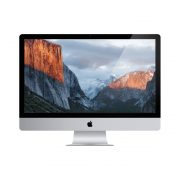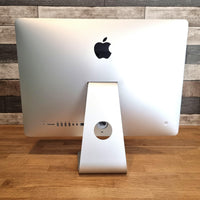
- Imac 27 late 2013 used 512ssd hd 16gbram how to#
- Imac 27 late 2013 used 512ssd hd 16gbram upgrade#
- Imac 27 late 2013 used 512ssd hd 16gbram pro#
- Imac 27 late 2013 used 512ssd hd 16gbram free#
- Imac 27 late 2013 used 512ssd hd 16gbram mac#
Imac 27 late 2013 used 512ssd hd 16gbram pro#
I purchased a Thunderbolt 3 external SSD from Other World Computing, the 1 TB model of the Envoy Pro EX, for just under $300, which is rated at 2800 MBps. SSDs these days rely on NVM Express, a standard built on top of PCI Express, which can offer up to 10 times the rate, challenging the top rates offered by Thunderbolt 3. Since then, however, technology and pricing have improved by leaps. SATA III SSDs top out just below 600 MBps (around 5 Gbps, USB 3’s base-level speed), which is a few times faster than even a 7200 rpm hard drive. Such SSDs package flash memory in a 2.5-inch drive case but are limited by the SATA III throughput rates.
Imac 27 late 2013 used 512ssd hd 16gbram mac#
With a couple of previous Mac minis, I had switched to an affordable 512 GB external startup drive that used an external SSD in a SATA III format and connected via USB 3. The solution was obvious-I needed faster storage on the iMac. I began using screen sharing to avoid waiting several minutes for Adobe InDesign or Photoshop to launch they launched in about 10 seconds on my MacBook Air. Worse, even when using Rosetta 2 emulation for Adobe Creative Cloud apps like Photoshop (before the recent release of an M1-native version), the MacBook Air swept the floor with my iMac.

Despite having just 16 GB of memory, the M1 MacBook Air runs measurably far faster than my iMac. Do you remember first seeing a Retina display? I remember glancing at one and thinking, “Oh, no, I must not get used to this, or my current screen will seem like it’s composed of giant blocky pixels.” Eventually, my budget let me move to Retina. Purchasing an M1-based MacBook Air finally pushed me over the edge. I soldiered on for another 18 months, through the Catalina release and then macOS 11 Big Sur, upgrading my Mac laptop to each in turn for researching and writing. Parallels Desktop requires heavy disk usage, and it was a slug alongside other apps, even with so much memory available. I chose the cheapest path again, which was upgrading to 64 GB of memory and selling my previous 32 GB to a friend. A shift to Catalina would require additional resources to run a virtual machine effectively so I could keep Mojave available for those two apps (see “ Moving to Catalina: Keep Your 32-Bit Mac Apps Running with Parallels,” 18 September 2019). It was only once I upgraded to 10.14 Mojave that I found myself waiting seemingly forever for apps to launch and disk-intensive tasks to finish.Īs I grew increasingly frustrated, 10.15 Catalina appeared in late 2019, and I had two critical 32-bit apps I wanted to keep using indefinitely. The Fusion Drive initially suited me well with macOS 10.12 Sierra and seemed to sail through 10.13 High Sierra without causing me grief. I didn’t notice the performance tradeoff most of the time. (See “ iMac 1 TB Fusion Drives Have Smaller SSDs,” 7 August 2017.) However, Apple had just shifted to including substantially smaller SSDs in Fusion Drives, which I believe ultimately became a huge liability.
Imac 27 late 2013 used 512ssd hd 16gbram upgrade#
At the time, spending $300 for a 512 GB SSD didn’t make sense because I needed more storage, and $700 for the 1 TB SSD upgrade was too dear for my budget.

While I had configured it with 32 GB of memory, I opted for a 1 TB Fusion Drive, Apple’s combination of a fast, low-capacity SSD with a slow 5400 rpm, high-capacity hard drive. When I bought the iMac, I unfortunately cheaped out in one important regard.

But it took me until two weeks ago to truly unleash its power. When I purchased a quad-core 21.5-inch iMac with Retina display in 2017 and added a secondary 4K display, I felt that I had spent the right amount of money relative to my needs. With a few delightful exceptions that involve printing history and letterpress, I spend most of my day looking at a screen, tapping away on a keyboard, and manipulating a mouse.
Imac 27 late 2013 used 512ssd hd 16gbram free#
#1621: Apple Q3 2022 financials, Slack's new free plan restrictions, which OS features do you use?.#1622: OS feature survey results, Continuity Camera webcam preview, OWC miniStack STX.
Imac 27 late 2013 used 512ssd hd 16gbram how to#
#1623: How to turn off YouTube's PiP, use AirPlay to Mac, and securely erase Mac drives.


 0 kommentar(er)
0 kommentar(er)
